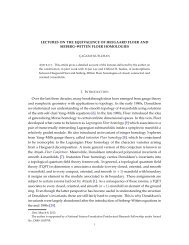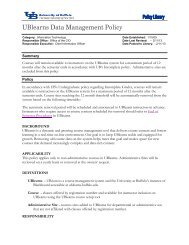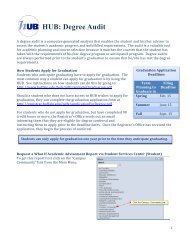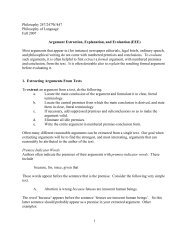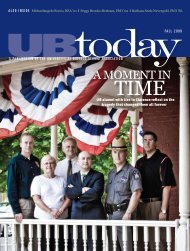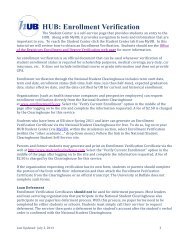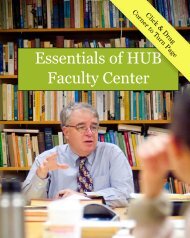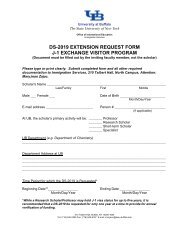A WALK IN THE WOODS - University at Buffalo
A WALK IN THE WOODS - University at Buffalo
A WALK IN THE WOODS - University at Buffalo
You also want an ePaper? Increase the reach of your titles
YUMPU automatically turns print PDFs into web optimized ePapers that Google loves.
shortformERIC HANSONRESEARCH NEWSSolar cells may offerpower on the goImagine hiking an isol<strong>at</strong>ed stretch of the Appalachian Trail. Youfear you’re lost. The trail map isn’t helping. And the b<strong>at</strong>tery in yoursmartphone, with its GPS unit, is dead. “Man,” you nervously say toyourself, “I wish I could charge my phone.”Being stuck in a remote area with limited or no access toelectricity is more common than you might think. Just ask a soldier,a lumberjack or an angler. It’ll soon be less common, however,because researchers are developing energy-harvesting solar cellsth<strong>at</strong> can be sewn into clothing, backpacks and other m<strong>at</strong>erials.“They work like conventional solar cells but, because theyare flexible, like paper, we can affix them to many surfaces,”says Qiaoqiang Gan, assistant professor of electrical engineering.“With flexible solar cells, we can provide soldiers, hikersand other people on-the-go with a means to power their electronicdevices.”Before th<strong>at</strong> happens, researchers must find a way to makeflexible solar cells more efficient and less expensive to manufacture.Gan is tackling the problem with the help from a teamof UB researchers and gradu<strong>at</strong>e students.Thin-film solar cells now used in industry are easy to installand lightweight, and they can be rolled onto rooftops like acarpet is rolled onto a floor. Made of silicon and other inorganicm<strong>at</strong>erials, they’re generally more costly to manufacture thanconventional solar panels. On the other hand, liquid-based solarcells—the type Gan is working on—are a kind of thin-film solarcell. But because they come in liquid form, they can be affixed toa gre<strong>at</strong>er variety of surfaces.“Unlike wh<strong>at</strong>’s available today, liquid-based solarcells are not rigid. They’re flexible, like paper,” Ganreiter<strong>at</strong>es. “As a result, they can be fabric<strong>at</strong>ed over large areas,potentially becoming as inexpensive as paint.” The referenceto paint does not include a price point but r<strong>at</strong>her the idea th<strong>at</strong>liquid solar cells could one day be applied to surfaces as easilyas paint is to walls.The main reason liquid-based solar cells aren’t yet for saleis th<strong>at</strong> they don’t produce enough power to make them competitivewith other solar panels. Gan is working to change th<strong>at</strong>,using an assortment of high-powered computers, lasers andother gadgets to devise ways to incorpor<strong>at</strong>e tiny bits of metalinto solar cells. The metal, when placed next to the solar cells,should help them convert more sunlight into electricity.So far, he has conducted computer simul<strong>at</strong>ions th<strong>at</strong> suggestthe nanostructure will significantly boost the solar cell’spower conversion. Gan will work with Alexander N. Cartwright,UB professor of electrical engineering and biomedical engineering,and vice president for research and economic development,to combine the metal and the solar cell. The results, he sayswith a grin, should be electrifying.UNIVERSITY NEWSShake, r<strong>at</strong>tle and not much rollEarly results from an earthquake simul<strong>at</strong>ion test suggest th<strong>at</strong> cold-formed-steel buildingsmay be able to withstand major earthquakes. Researchers from The Johns Hopkins<strong>University</strong>, who led the experiment Aug. 16 <strong>at</strong> UB’s Structural Engineering and EarthquakeSimul<strong>at</strong>ion Labor<strong>at</strong>ory, programmed the shake tables to mimic ground forces feltduring 1994’s c<strong>at</strong>astrophic earthquake in Northridge, Calif. During the test, the shaketables violently jolted the building back and forth, causing cracks to interior and exteriorwalls. But the building, based on preliminary analysis, withstood the quake’s forces.6 UBTODAY Fall 2013 www.buffalo.edu/ubt



